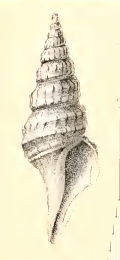Epidirella xanthophaes facts for kids
Quick facts for kids Epidirella xanthophaes |
|
|---|---|
 |
|
| Original image of a shell of Epidirella xanthophaes | |
| Scientific classification | |
| Synonyms | |
|
Epidirella xanthophaes is a type of sea snail. It's a marine mollusk that belongs to the family called Turridae. These snails are often known as turrids.
Contents
What Does Epidirella xanthophaes Look Like?
The shell of this sea snail can be anywhere from 18 to 28 millimeters long. That's about the size of a small button or a large paperclip!
The shell is tall and narrow. It has a shape that tapers at both ends, which is called fusiform. It also has two main ridges, or "keels," that run around it. These keels have small bumps, like tiny tubercles. The shell is a yellowish-brown color, called fulvous, with brown spots between the bumps.
Shell Details and Patterns
The shell's surface has rough lines that show how it grew. It also has many different spiral threads. Just below the top edge, there's a wide thread that looks wrinkled. Below this, on the "shoulder" of the shell, are three faint threads.
The main corner of the shoulder has a strong, rounded keel. This keel has white, blunt bumps with chestnut-colored spots between them. Below this, there's a wide groove with more faint threads inside it. Another keel, similar to the first but weaker, forms the lower side of this groove.
The shell then narrows down. It has more threads on the front part of its base and on the central pillar, called the columella. The very tip of the columella is rough but has no threads.
Color and Shape of the Shell
The shell is mostly yellowish-brown with white and chestnut spots. The tip of its "snout" (the front part) is white.
The top part of the shell, called the spire, is tall and cone-shaped. It looks like it has a crown at its very tip, or apex. The shell has seven full turns, or whorls, not counting the apex. These whorls grow slowly and steadily.
The main body whorl is small. It has a rounded, long base and a small, somewhat long siphonal canal. This canal helps the snail breathe and sense its surroundings. The line where the whorls meet, called the suture, is very clear because of the narrow part above it.
The opening of the shell, called the aperture, is shaped like a club. The outer edge of the opening, the lip, is thin. It has a strong, V-shaped notch or sinus that starts from the suture. This notch is important for the snail's breathing tube. The inner lip is thin and curves inward.
Life Cycle and Reproduction
Epidirella xanthophaes snails are usually either male or female. They reproduce by releasing their eggs and sperm into the water, a process called broadcast spawning.
Their life journey starts as tiny embryos. These embryos grow into planktonic trocophore larvae, which are free-swimming and float in the ocean. Later, they change into juvenile veligers, which are still tiny and floating. Eventually, they settle down and grow into the adult snails we see.
Where Does Epidirella xanthophaes Live?
This marine snail lives off the coasts of New South Wales and Tasmania in Australia. You can find them in the ocean at depths between 37 meters and 161 meters. That's like finding them at the bottom of a swimming pool, or even much deeper!

